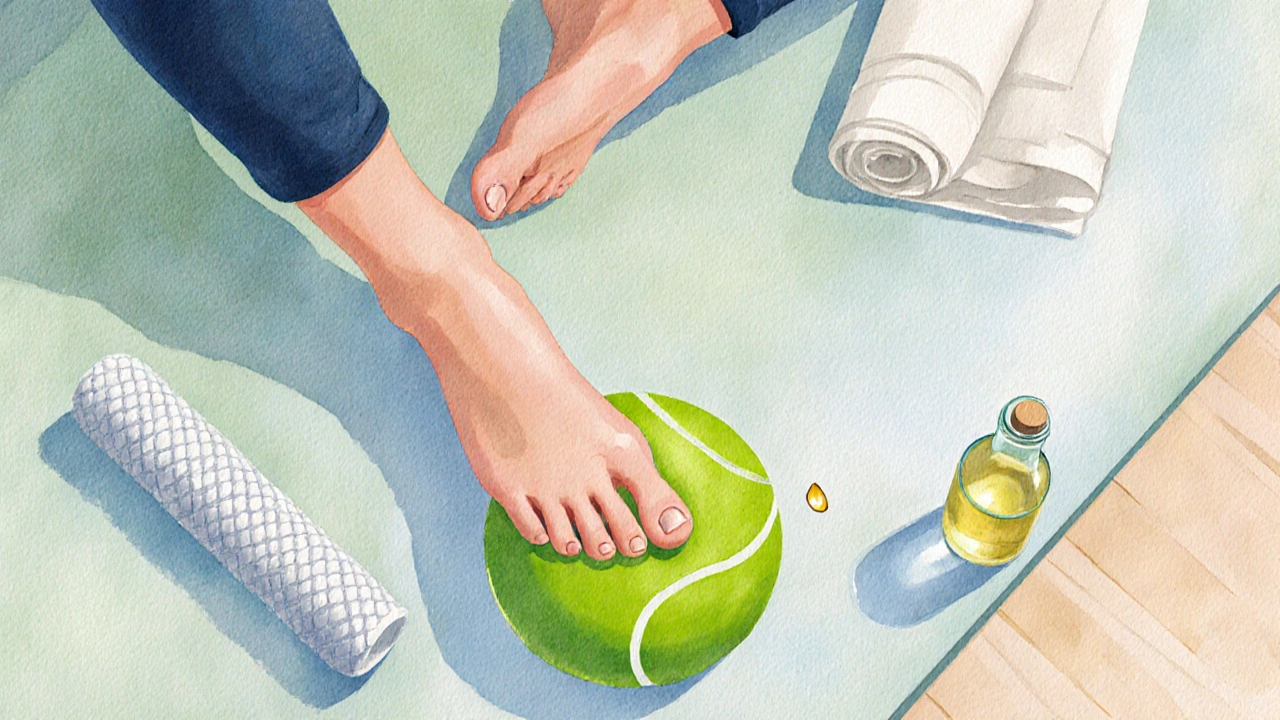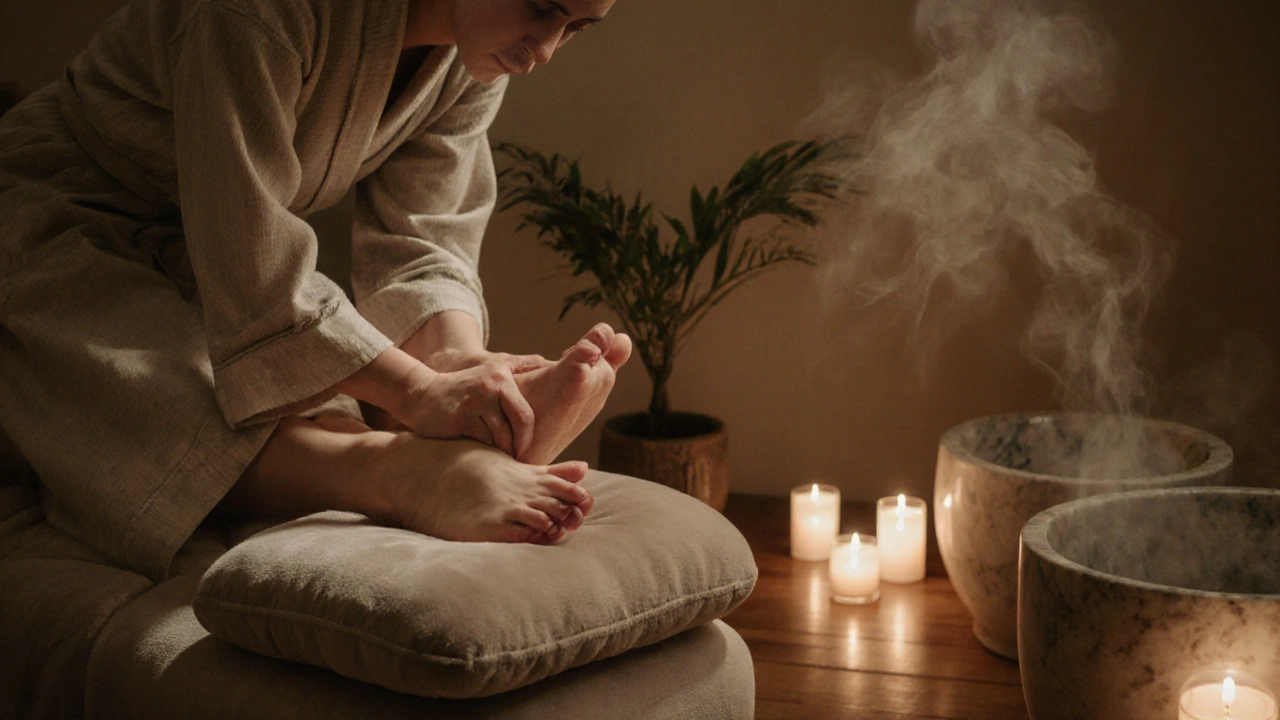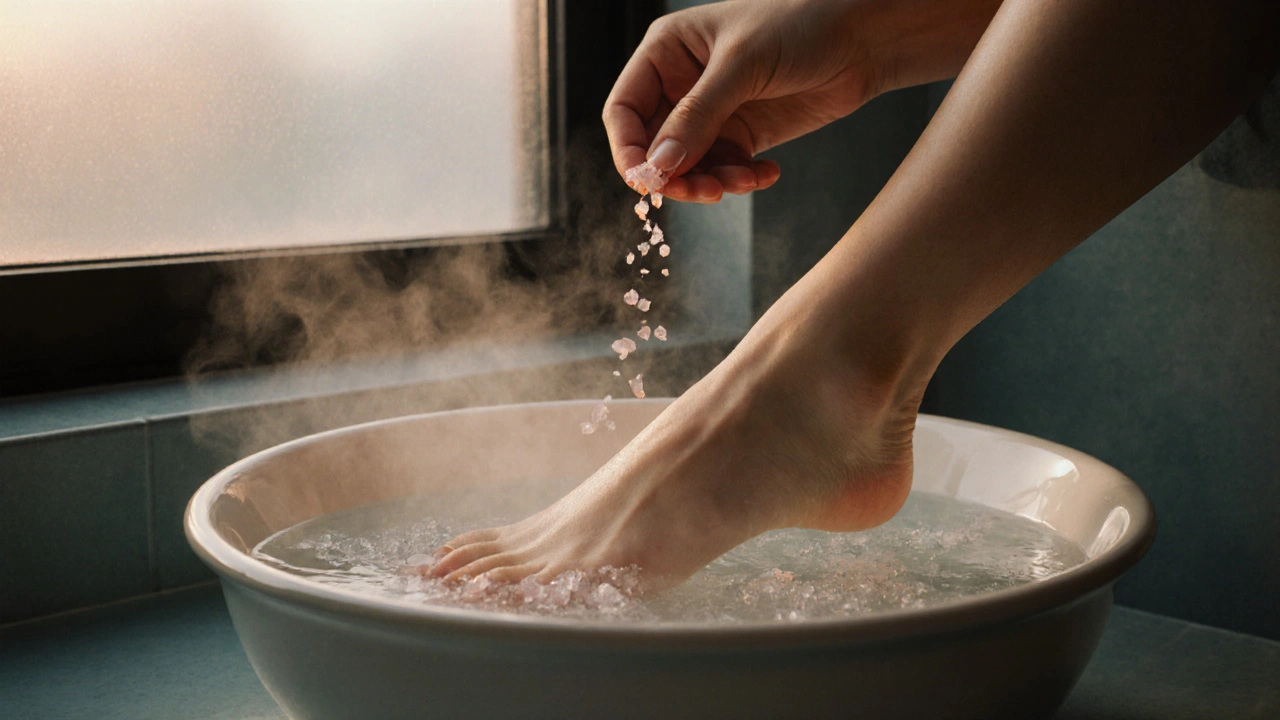Key Takeaways
- Warm soak, gentle stretch, and targeted pressure can melt foot pain in minutes.
- Use everyday items - a tennis ball, a foam roller, or even a rolled towel - for effective self‑massage.
- Know the difference between a relaxing foot massage and therapeutic reflexology.
- Stay safe: avoid deep pressure on acute injuries and keep nails trimmed.
- Consistent routine (once or twice a week) prevents soreness from building up.
Direct Answer
If your feet feel sore after a long day, start with a warm water soak, follow with simple stretches, then roll a tennis ball under the arch for 2‑3 minutes. Finish with a light massage using a few drops of oil or lotion. The whole sequence takes under ten minutes and often leaves you walking on clouds.
Comprehensive Guide to Foot Massage Tips
We’ve all been there - a hectic workday ends, you kick off your shoes, and your feet scream for mercy. The good news? You don’t need a pricey spa to give them relief. A few mindful moves at home can erase the ache, boost circulation, and even improve your mood. Below you’ll find a step‑by‑step plan, the science behind it, and a quick reference table if you’re deciding between a classic foot massage and a more specialized reflexology session.
Definition and Context
Foot massage is a manual therapy that applies pressure, kneading, and stretching to the muscles, tendons, and soft tissue of the feet. It traces its roots to ancient Chinese and Egyptian healing practices, but today it’s a staple in wellness centers worldwide. While some people think of it as a luxury, foot massage actually serves a therapeutic purpose: relieving tension, improving blood flow, and reducing post‑exercise soreness.
Benefits of Foot Massage
Beyond the immediate “ahh” feeling, regular foot massage can:
- Lower cortisol levels, helping you manage stress.
- Enhance lymphatic drainage, which reduces swelling.
- Alleviate symptoms of Plantar fasciitis by loosening the plantar fascia ligament.
- Boost proprioception - the body’s sense of position - which can improve balance.
- Support better sleep, especially when paired with a calming bedtime routine.

Types of Foot Massage Available
Knowing the style you want helps you pick the right technique or therapist. Here’s a quick rundown:
- Swedish foot massage: Light strokes, gentle kneading, perfect for relaxation.
- Deep tissue foot massage: Stronger pressure targeting knots and chronic tension.
- Reflexology: Reflexology maps foot zones to organs and systems, applying pressure to specific points to influence the whole body.
- Acupressure foot massage: Uses Chinese meridian points to balance energy flow.
How to Perform a Self‑Foot Massage at Home
- Warm soak (2‑3 minutes): Fill a basin with hot water (about 40 °C) and add a handful of Epsom salt magnesium sulfate that relaxes muscles. Soak to soften skin and increase circulation.
- Gentle stretch (1 minute): Sit, extend one leg, and pull your toes toward you. Hold for 15 seconds, then release. Repeat three times per foot.
- Rolling massage (2‑3 minutes): Place a tennis ball or a Foam roller cylindrical foam tool for myofascial release on the floor. Roll each foot back and forth, focusing on the arch and heel.
- Targeted kneading (2 minutes): Using your thumbs, press firmly into the ball of the foot, then glide toward the heel. Apply a circular motion for about 30 seconds on each spot.
- Finish with oil (30 seconds): Drizzle a few drops of Massage oil light carrier oil such as sweet almond or jojoba and gently rub it in. The oil reduces friction and leaves the skin supple.
Do this routine once or twice a week, and you’ll notice less stiffness and faster recovery after long walks or workouts.
Tools and Aids You Can Use
While your hands are the star, a few props make the job easier:
- Tennis ball or lacrosse ball: Excellent for pinpoint pressure on the arch.
- Foam roller: Provides broader surface area for myofascial release.
- Roll‑up towel: Can be used to stretch the plantar fascia before massage.
- Massage oil or lotion: Prevents skin irritation and adds a soothing scent.
What to Expect During a Professional Session
If you decide to visit a spa, the experience usually follows this flow:
- Consultation - therapist asks about pain locations, health conditions, and preferences.
- Warm foot soak - often with essential oils or herbal blends.
- Massage - therapist uses a blend of Swedish strokes, reflexology points, or deep tissue pressure based on your needs.
- Finish - gentle stretching and a light foot massage with cream or oil.
A typical 30‑minute session costs between $40‑$80 in London, though many places offer discounted packages for regular clients.

Pricing and Booking
When you’re scouting a clinic, compare:
- Session length (30 vs. 60 minutes).
- Techniques included (does the price cover reflexology points?).
- Location convenience - a spa near your home or workplace makes it easier to keep a routine.
Book online through the spa’s website or call ahead to ask about first‑time discounts.
Safety Tips
- Never massage directly over an open wound or infection.
- If you have diabetes, check your foot temperature and skin integrity before starting. Consult a physician if you notice numbness.
- Avoid deep pressure on acute ankle sprains - gentle range‑of‑motion exercises are safer.
- Trim toenails regularly to prevent accidental scratching.
- Start with light pressure; increase gradually as your tolerance builds.
Comparison Table: Foot Massage vs. Reflexology in London
| Aspect | Foot Massage | Reflexology |
|---|---|---|
| Primary Goal | Relaxation and muscle tension relief | Influence organ systems through pressure points |
| Typical Pressure | Light to moderate, adjustable | Often firmer on specific zones |
| Session Length | 30‑45 min | 45‑60 min |
| Cost (London average) | £40‑£60 | £60‑£90 |
| Ideal For | General soreness, post‑exercise recovery | People seeking holistic health benefits, chronic conditions |
FAQ: Your Questions About Foot Massage Answered
How often should I do a foot massage?
Two to three times a week is enough for most people. If you’re an athlete or spend a lot of time on your feet, a daily short routine can help prevent buildup of tension.
Can foot massage help with plantar fasciitis?
Yes. Gentle stretching combined with targeted pressure on the arch can loosen the fascia and reduce morning pain. Pair massage with night splints for best results.
Is it safe to use a tennis ball on sore feet?
Absolutely, as long as you keep the pressure moderate and avoid rolling over any sharp bone protrusions or bruises.
Do I need special oil for a foot massage?
A light carrier oil like sweet almond or jojoba works well. If you have sensitive skin, choose a fragrance‑free version.
What’s the difference between foot massage and reflexology?
Foot massage focuses on muscle relaxation and blood flow, while reflexology targets specific pressure points that correspond to internal organs, aiming for systemic health benefits.
Ready to Give Your Feet Some Love?
Take the first step tonight: fill a basin, grab a tennis ball, and try the five‑minute routine. Your feet will thank you tomorrow, and you’ll have a simple habit that keeps soreness at bay.


Millennial Avid
October 20, 2025 AT 19:17Yo, fellow foot‑warriors! 🌈 Dive into that warm soak like it’s a spa‑level immersion, then unleash the power of a tennis ball-think of it as a micro‑massager that triggers myofascial release on steroids. The synergy of stretch, roll, and a dash of essential oil creates a cascade of vasodilation, flushing out lactic acid faster than a sprint. Keep the routine consistent and you’ll be strutting on clouds, literally feeling that post‑exercise euphoria. 🎉
Sara Gibson
November 13, 2025 AT 18:17Consider your feet as the grounding anchors of existential flow-when they’re bruised, your whole being vibrates out of sync. By channeling the ancient reflexology paradigm, you re‑align your chi and restore homeostatic balance, which in turn fuels mental resilience. Each stretch is a micro‑ritual, a kinetic mantra that amplifies neuroplasticity and primes your nervous system for peak performance. So ignite your routine, treat the arch like a sacred conduit, and watch your daily vigor amplify exponentially. Your soles will thank you, and your mind will thank the universe for the harmonious feedback loop.